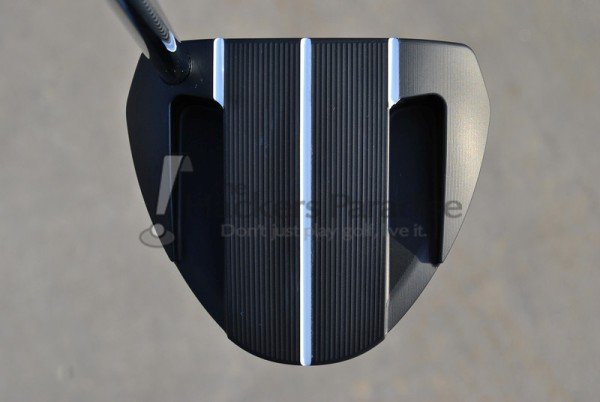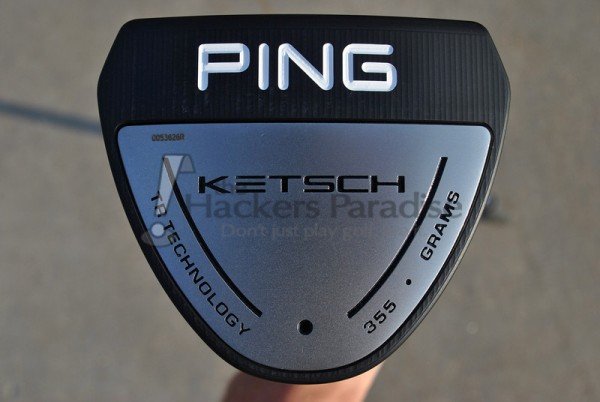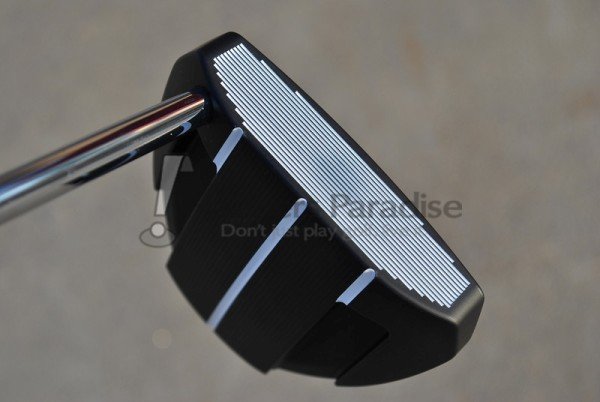PING Ketsch Putter Review
Known for introducing some of the more eclectic looking mallet putters we have seen in golf, PING is now bringing their highly touted True Roll Technology into a full-fledged mallet. However, in design and shape, this one is based on simplicity and effectiveness.

PING on the Ketsch Putter:
The Ketsch stands out for the captured look it provides with the ball at address, inspiring confidence and promoting a consistent stroke, the #1 key to holing more putts. Three white, contrasting sightlines extend from the lead edge of the matte-black crown to make aiming easy. A 17-4 stainless steel sole weight in the aluminum head, precision-milled at PING, creates a high MOI for elevating forgiveness to improve accuracy.
Putter Specifications:
Key Technology:
- True Roll Technology
Variable-depth grooves in the face ensure ball-speed consistency whether the ball is struck in the center, or toward the heel or toe. Deepest in the center and shallower toward the perimeter, this innovative True Roll (TR) Technology equalizes ball speeds across the face for unmatched distance control. PING studies show an increase in ball-speed consistency of nearly 50% compared to a non-grooved face when measured at nine points across the face.
The True Roll Technology is something that PING has truly jumped all-in on since the initial insert version release last year. Rather than an insert, the grooves are milled into the aluminum body of the head, essentially creating what PING considers the best of both worlds – milled face feedback with TR technology. With the Ketsch, the grooves cover the entirety of the face and when tilted you can actually see the circular pattern in the middle of the face, as the grooves are deeper there compared to the more shallow perimeter.
- Adjustable Length and Various Arc Profiles
To optimize the fit for your body type and putting style, you can choose a fixed-length shaft (35″ is standard). Or you can upgrade to a USGA/R&A-conforming, adjustable-length, telescoping shaft that allows you to modify length between 31″ and 38″ prior to a round. The Ketsch is available in three shaft bends to fit any stroke type: Straight, Slight Arc, or Strong Arc. Results from hundreds of player and robot tests at PING show that you’ll putt more consistently when your putter balance matches your stroke type. The midsize PP58 black rubber grip is designed to keep the wrists firm and ensure a stable stroke for improved accuracy and consistency.
It wouldn’t be a stretch to say that historically, no equipment company has been as adamant about proper fitting of golf clubs as PING has been. From their static fitting system and easy-to-understand color codes, fitting has always been a major emphasis. In recent times we have seen that philosophy evolve even more with putters to include an adjustable length setup (optional), and in the case of the Ketsch, three different shaft bends to fit different strokes. The various shaft bends affect the amount of toe hang that the putter will have. More toe hang will aid a stroke with more arc and vise-versa.
Aesthetics:
The Ketsch is a full mallet that has a slight triangular resemblance to its overall shape. It’s a very balanced look that allows the various design elements to flow well together. The matte black finish serves its purpose of preventing glare while giving a good contrast to both the ball and white alignment lines. This also helps make the putter a bit sleeker in its size and appearance. The look at address is rounded out by an elongated central flange section that is the exact width of the golf ball. Additionally, there are two “cavity” sections that run parallel to the main flange line that are followed by a wing like cutout, which looks quite nice through the stroke and rounds out the appearance at address quite well.
The face and sole of the Ketsch may not be the main focal point of the putter at address, but they certainly were not overlooked by PING. The True Roll grooves really stand out thanks to the white fill in them, as that allows the user to see the variable depth pattern when in hand. The sole plate, which is literally a stainless steel plate installed into the aluminum frame, features the brand milling and is one of the cleanest and most classic aesthetic looks that PING has put into one of their putters in some time.
Performance:
The Ketsch putter used for this review was the standard 35” non-adjustable version with the straight arc weighting.
- Balance/Alignment:
The Ketsch is easily one of the most well balanced mallet putters that this reviewer has spent time with, both through the stroke and in the manner of which it sets up. Much of this free flow through the stroke is thanks to the combination of the aluminum body with the 17-4 stainless steel plate inserted into the sole. This not only lowers the CG of the putter, but it also increases the overall MOI to provide more confidence in the resiliency of strikes across the face. At no point does any stroke feel like “work” with this putter. It wants to release itself and requires no manipulation, which is always a sign of a solid mallet design.
Alignment is where the Ketsch might be at its most underrated. It obviously possesses similarities and differences from some of the most popular alignment setups we see on putters. The elongated section down the center of the flange mirrors the width of the golf ball ideally, and the siteline that runs through its center is also surrounded by parallel milling, which only strengthens alignment confidence at setup. The less common features here are the mock “wings” at the outside edges of the putter and the additional short topline sitelines at the edges of the central flange section. While the actual lines mark the literal framing of the golf ball well, the wings aid the general face alignment of the putter, helping to make sure you don’t set up open or closed at address. Even with all that is going on here, it manages to work throughout setup and the stroke without ever feeling like it is too much. It’s not an easy thing to accomplish, but PING did well with it here.
- Sound/Feel
Being that the body of the Ketsch is made of aluminum, the initial expectation of the sound/feel is that the putter would be like most high MOI aluminum mallets and have a springy sensation and higher pitched sound to it. However, thanks to the stainless steel soleplate providing some mass within the lightweight body and the TR grooves removing surface area that actually contact the ball, the Ketsch instead has a nice muted click to it at impact. The putter really has a sound/feel more like a traditional blade or mid-mallet as compared to a full mallet.
- Center Putts and Lateral Misses:
Studies done by PING that led to the development of the TR grooves showed that deeper grooves actually slow the overall roll, which makes sense. As the grooves become deeper, the more dampening effect there can be behind the ball at impact. With that, placing the deepest grooves in the center and more shallow ones to the perimeter is supposed to allow more consistency on overall distance regardless of where on the face the putt is stuck.
Overall, this held true during testing. Although there will inevitably be a feel difference on putts on the toe or heel compared to the center of the face, the general pace and rollout that was seen on them was impressively similar. To put this to the test a series of putts off of all three locations (heel, toe, and center) were taken in coordination with marking the backswing and follow through of the stroke to get it as repeatable and equal as possible. What was found is that although the direction will still be impacted on a miss, the overall distances on heel and toe strikes compared to center putts was inside of one foot time and again. Though nothing will fix a poor line or general directional miss, when it comes to overall distance consistency the combination of the TR grooves and the high MOI design/balance of the Ketsch headshape definitely has something to it, as it is one of the most accurate mallets this reviewer has ever spent time with.
Parting Thoughts:
Sometimes form and function come together better than anticipated to truly surprise and the Ketsch can certainly be considered an example of that. Added to the 2014 PING lineup without much fanfare and initially just looked at as “another mallet” by many, instead it is a well-balanced, clean, and effective putter with a good story and technology behind it. For mallet fans it is a putter that is definitely worth spending time with, as the distance consistency, accuracy, and feel will speak for themselves with many golfers. Add in the adjustable length models and three different arc profiles and there is something for everyone to try.
The Ketsch putter has an MSRP of $199.99 and more information can be found at www.ping.com.



















Well done James! This sounds promising. The flexibility in fitting a golfer is huge. The feel of a balanced head address has my interest the most. I’ve had other mallets that seem to miss that mark. I will take a few rolls with this to see if it a fit for me.
Good stuff as always, James. The Ketsch is one that caught my eye early on, being a shape that I love paired with the TR insert that impressed me last year. I need to find one of these guys and give it a roll.
Thanks for the hard work!
Well done James, at first glance it seems quite large, but I love the full features of the TR, hopefully I can find one to give a roll soon.
Solid review here James. You’re take on the grooves is what stands out to me the most as it relates to the Pure Roll technology and how consistent it is across the face. At first glance, it doesn’t stand out for me and looks similar to other mallets that Ping has put out. I like the adjustability options throughout the model line for length as well.
Great review Jman! I like that the putter is available to fit different putting strokes rather than making consumers just simply pick a different model. I don’t know that I am in love with the whole adjustable length idea myself. Why not just offer it in various lengths and let people pick the one that fits them? Either way, I like the looks of this and really do like Ping’s Pure Roll technology. I’ll have to check this baby out!
Nice writeup, James. Love the TR technology.
Great review. I really like the looks and technology on this one. I wish the review included the adjustable one. I’m wondering how stable the adjustable one is.
The Ketsch is hard to find around my parts but finally did a demo and LOVED it! I am currently using an older Odyssey Marxman and while it works great, this Ketsch was like putting with cruise control. Nice feel on short, med and long putts and easy to aim. The one thing it did well was putt from far away and reached the hole every time. I demoed a Cameron GoLo that same day and maybe it was just me, but the Ketsch was head and shoulders above the Cameron especially on long putts. (note, I’m just an average golfer shooting in the mid to high 80’s). I’m going to purchase this putter and see how it does on a full round of golf soon. Thanks for your review. This putter should really be on the front page of most lists for average golfers but hardly gets any attention.
A little last to the show, but enjoyed that review. Getting back into mallet putters